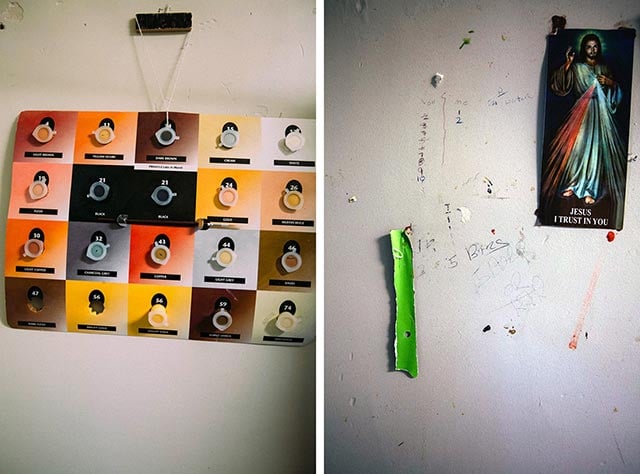
Photographs by Cindy Blažević and Essay by Ellyn Walker
More than a decade ago, Angela Y. Davis offered us this insight into our collective denial of the reality of mass incarceration:
There is reluctance to face the realities hidden within [prisons], a fear of thinking about what happens inside them. Thus, the prison is present in our lives and, at the same time, it is absent from our lives. To think about this simultaneous presence and absence is to begin to acknowledge the part played by ideology in shaping the way we interact with our social surroundings.
These words – from Davis’ book Are Prisons Obsolete? – point to a much-needed conversation around the ways we treat each other according to notions of “justice.” In her book, Davis identifies the profound tension between visibility and invisibility that operates around institutions of incarceration, and questions why ‘criminals’ constitute a particular class “of human beings undeserving of the civil and human rights accorded to others.” Through exploring such factors as racism, sexism, capitalism and coloniality (the ongoing global condition of colonialism), Davis demonstrates how “the prison is one of the most important features of our image environment,” as it reveals the imperative for reimagining how we both understand and practice justice.
“Through a Penal System, Darkly” (2013-15), a photo project by Toronto-based artist Cindy Blažević, builds on Davis’s perspective, documenting the recently defunct Kingston Penitentiary and inviting viewers to consider what happens inside closed doors. Working with upper-year law students from Osgoode Hall Law School as the inaugural artist-in-residence, Blažević and her collaborators researched historic and contemporary penal practices in Canada, alongside local and overarching abolitionist perspectives, in order to better contextualize the images and what they might mean to different viewers. In thinking through what is both present and absent in Blažević’s photographs, notions of justice and, relatedly, realities of injustice, are slowly revealed.
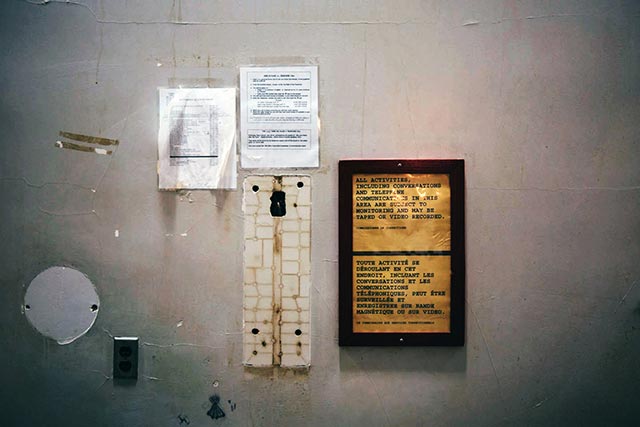 Access: the removal of a payphone from the wall during the decommissioning process leaves behind a rectangular outline. A list of phone numbers for outreach organizations and a bilingual sign warning prisoners their calls may be recorded remain. (Photo: Cindy Blažević)
Access: the removal of a payphone from the wall during the decommissioning process leaves behind a rectangular outline. A list of phone numbers for outreach organizations and a bilingual sign warning prisoners their calls may be recorded remain. (Photo: Cindy Blažević)
Opened in 1833 in Kingston, Ontario, Kingston Pen “was built in the context of [expanding] the Upper Canadian state,” whereby its location in the country’s former capital represents a particular kind of ‘moralizing’ project tied to early British-Canadian sovereignty, as documented by Simon Wallace. As the country’s first (and largest) prison, Kingston Pen’s distinct ‘workhouse’ style architecture echoed plantation design and master/slave spatializations, and at the time was meant to demonstrate the notion of carceral-not-corporal punishment. (This shift involved legalizing incarceration as a form of punishment rather than physical injury, as was historically used.) Kingston Pen represented one of the world’s longest-running prisons, up until it closed its doors in 2013 due to increasing maintenance costs and documented human rights violations. Uniquely, Blažević’s photographs give nuance to the site’s many histories, capturing Kingston Pen’s domineering architecture of control while at the same time revealing remnants of its humanity.
Blažević’s photographs act as prompts for reflection, as they are indexed rather than titled in an effort to encourage open-ended readings. In one of the works, catalogued as “Colonialism, Continued,” we see an illustration of a Plains-style teepee superimposed onto a photo of a small, enclosed prison yard – a place where Indigenous cultural practices would often take place. Here, Blažević’s pictorial intervention is informed by interviews with those who both lived and worked inside Kingston Pen, wherein their stories, they tell of a rare place for Indigenous belonging.
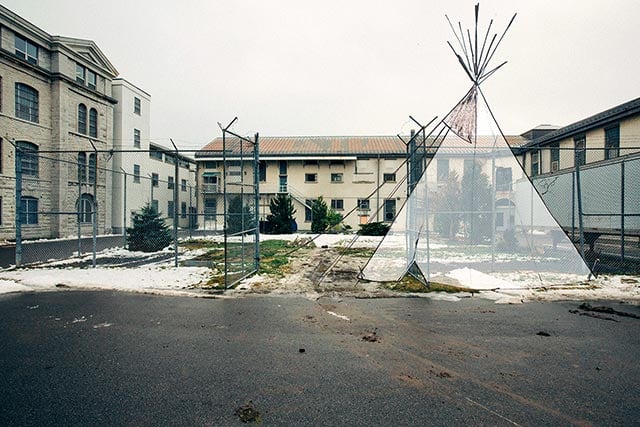 Colonialism, Continued: an illustration of a Plains-style teepee is superimposed onto a photo of a small, enclosed prison yard – a place where Indigenous cultural practices would often take place. The actual teepee was packed away, as part of the decommissioning process, before Blažević had a chance to photograph it. (Photo: Cindy Blažević)
Colonialism, Continued: an illustration of a Plains-style teepee is superimposed onto a photo of a small, enclosed prison yard – a place where Indigenous cultural practices would often take place. The actual teepee was packed away, as part of the decommissioning process, before Blažević had a chance to photograph it. (Photo: Cindy Blažević)
Located at the meeting of the St. Lawrence River and Lake Ontario, Kingston has been home to Indigenous peoples since time immemorial, and represents an important travel route and place of settlement for such groups as the Haudenosaunee and Anishinabek, before Europeans arrived. Today, however, Kingston represents a city of incarceration and coloniality – a place where the most prisons in Canada are located, and where Indigenous peoples make up the largest population of prisoners, which continues to grow at a seemingly steady rate.
These facts bring to mind a number of important and unsettling questions: How is it that in a country where Indigenous peoples make up less than 4 percent of the population, they also represent the largest population of prisoners? What does this say about notions of justice, and the continued impact of colonialism on our society, including its social relations and geographies? Alas, these statistics are not just a Canadian phenomenon, as sociologist Luana Ross reminds us: “Prisons, as employed by the Euro-American system, operate to keep Native Americans in a colonial situation,” where “Native people are vastly overrepresented in federal and state prisons,” reflective of the lasting effects of white supremacy and cultural genocide.
“The Bleach Treatment,” a diptych photograph that juxtaposes two different views of the same prison exterior, recalls disturbing images of African-American lynchings as seen throughout history. Within Blažević’s composite image, a birch tree and empty plant-holder stand vertically in front of banal prison walls, as if dangling an invisible body for spectators to see. Today, however, the black body is hardly invisible – as it is the body of the late Trayvon Martin, Michael Brown and Sandra Bland that quickly come to mind, in addition to the thousands of other victims to state violence, which operates both inside and outside of the prison.
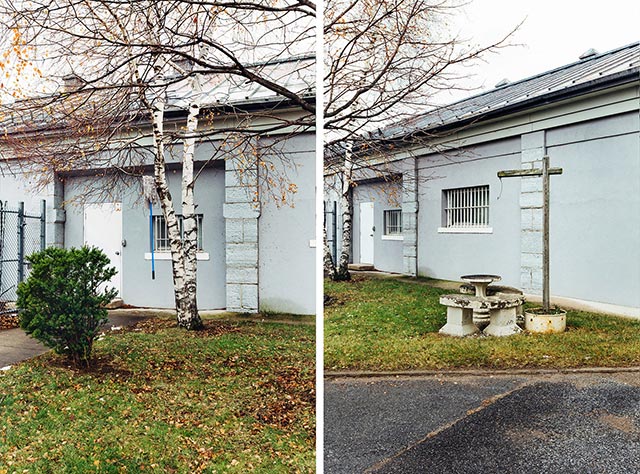 The Bleach Treatment: a blue-handled mop hangs, suggestively, from a birch tree and a wire for a hanging plant dangles, also suggestively, next to a stone seating area inside prison grounds. (Photo: Cindy Blažević)
The Bleach Treatment: a blue-handled mop hangs, suggestively, from a birch tree and a wire for a hanging plant dangles, also suggestively, next to a stone seating area inside prison grounds. (Photo: Cindy Blažević)
The Black Lives Matter website explains, “How 2.8 million Black people are locked in cages in [the United States] is state violence. How Black women bearing the burden of relentless assault on our children and our families is state violence.” This link made to the family is no coincidence, as imprisonment is undeniably a family experience, explains Dr. Nancy Loucks in her study on prisoners’ families. Blažević’s image of a child’s jungle gym in front of a family visiting unit reminds us of this fact (see “Maslow’s Hierarchy”), where in the image we see this familial scene through the perspective of a chain-linked fence. The fence helps Blažević acutely capture the inside/outside dynamics of social control at play in such spaces, where family members are also “punished through incarceration even though they are not the ones who have been accused or sentenced,” explains Loucks. Family members typically “experience restricted rights, diminished resources and social marginalization,” all of which can be in addition to the effects of intergenerational trauma, such as with foster homes or Residential Schools, as documented by M. L. Comfort.
Few prison visitation programs are designed to encourage visits, though it is so often the connection to family that can help prisoners both imagine and practice freedom. In Outlaw Culture: Resisting Representations, bell hooks writes, “the moment we choose to love we begin to move against domination, against oppression […] to move towards freedom [and] to act in ways that liberate ourselves and others. That action is the testimony of love as the practice of freedom.” With this perspective, one must consider deeply the ways in which justice and compassion go hand-in-hand, in particular, in spaces of extreme vulnerability and oppression, such as the prison.
If prisons function as “abstract site[s] into which undesirables are deposited, relieving us of the responsibility of thinking about the real issues afflicting those communities from which prisons are drawn in such disproportionate numbers,” argues Davis, then we must develop close relations with prisons and their lived realities. Blažević’s photographs allow us to do so – offering viewers candid evidence of lives lived inside Kingston Pen, and the many ways that prisons obscure our individual and collective responsibilities of taking seriously the ongoing problems of our society, particularly those produced by racism, colonialism, patriarchy and global capitalism. As Davis reminds us, “the most difficult and urgent challenge today is that of creatively exploring new terrains of justice, where the prison no longer serves as our major anchor,” and where we can “adopt more complicated, critical postures toward the present and the future.” Blažević’s images offer us reflections of a recent past of a site in which complex human relations and their distinct histories are each at stake and yet are irreconcilable, and that demands an active and ongoing reimagining in order to ensure a more just future.
The full version of “Through A Penal System, Darkly” can be seen here.
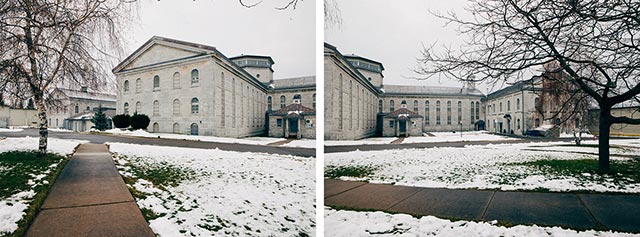 Design for Another Era: walkways intersect in front of the grandiose north facade of the main cellblock building (left) and an admin building (right) that was once used as a chapel and a dining hall. (Photo: Cindy Blažević)
Design for Another Era: walkways intersect in front of the grandiose north facade of the main cellblock building (left) and an admin building (right) that was once used as a chapel and a dining hall. (Photo: Cindy Blažević)
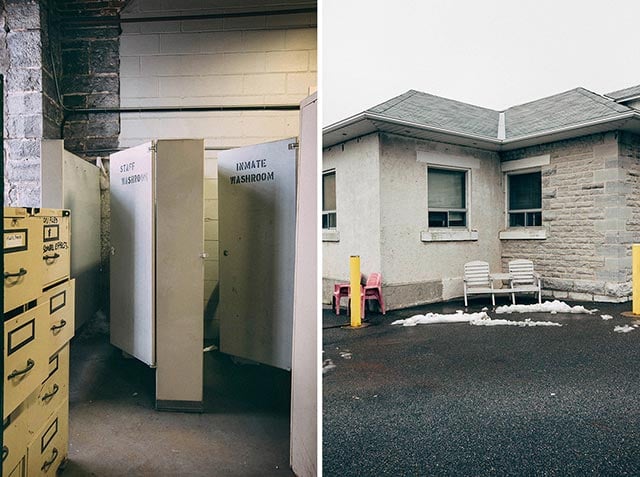 The Modern Correctional Officer: toilet cubicles in the metal workshop hint at some of the shared issues that staff (correctional officers) and prisoners face. Muskoka (Adirondack) chairs and pink lawn chairs, used by guards, sit in front of an admin building in a courtyard. (Photo: Cindy Blažević)
The Modern Correctional Officer: toilet cubicles in the metal workshop hint at some of the shared issues that staff (correctional officers) and prisoners face. Muskoka (Adirondack) chairs and pink lawn chairs, used by guards, sit in front of an admin building in a courtyard. (Photo: Cindy Blažević)
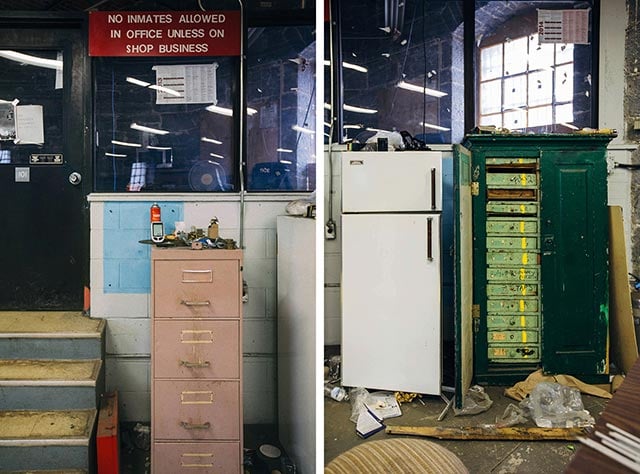 Imprisoning Women: Cabinets and a fridge sit in front of the control room window for the metal workshop. Blažević’s work notes that incarcerated women do not have the same programming opportunities (and hence post-prison work qualifications) that men do. (Photo: Cindy Blažević)
Imprisoning Women: Cabinets and a fridge sit in front of the control room window for the metal workshop. Blažević’s work notes that incarcerated women do not have the same programming opportunities (and hence post-prison work qualifications) that men do. (Photo: Cindy Blažević)
 Melting Pot: three cells painted by their inhabitants inside the recently shuttered Kingston Penitentiary. (Photo: Cindy Blažević)
Melting Pot: three cells painted by their inhabitants inside the recently shuttered Kingston Penitentiary. (Photo: Cindy Blažević)
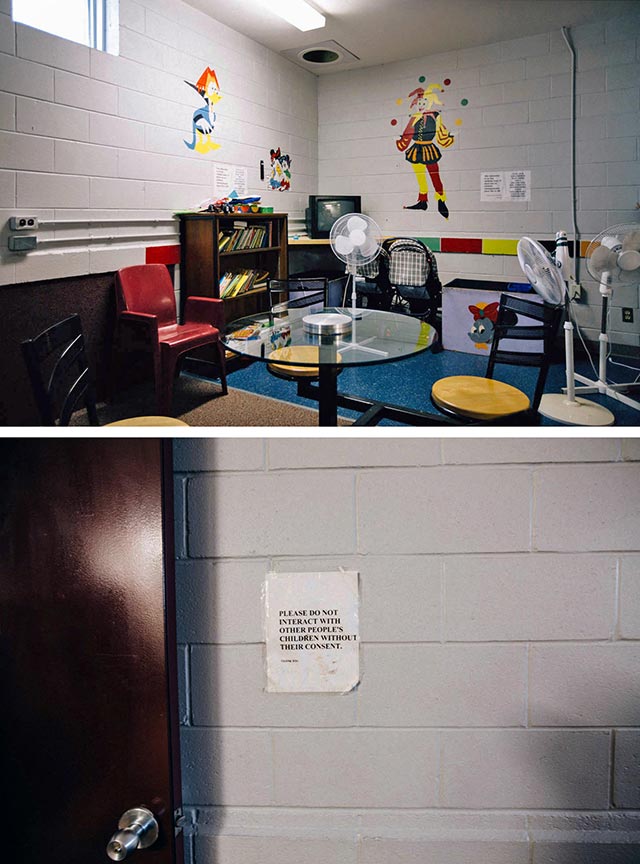 Stress: a children’s play area in the corner of a visitation room. A sign, below, offers a grammatically confusing warning to visitors and/or prisoners. Many participants in Blažević’s project note that the stress of incarceration extends well beyond the person being incarcerated. (Photo: Cindy Blažević)
Stress: a children’s play area in the corner of a visitation room. A sign, below, offers a grammatically confusing warning to visitors and/or prisoners. Many participants in Blažević’s project note that the stress of incarceration extends well beyond the person being incarcerated. (Photo: Cindy Blažević)
 The Only System That Can’t Say No: painted footprints indicate where male, female and child visitors should stand to be searched and/or sniffed by dogs for drugs and other contraband items. (Photo: Cindy Blažević)
The Only System That Can’t Say No: painted footprints indicate where male, female and child visitors should stand to be searched and/or sniffed by dogs for drugs and other contraband items. (Photo: Cindy Blažević)
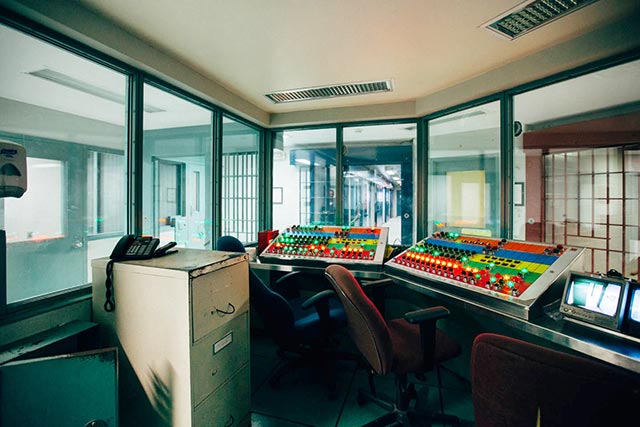 The Sound of Segregation: the interior view of the control post for the Dissociation Unit and Involuntary Segregation Unit. The green- and red-lit buttons control the cell doors, limiting interaction (and basic human contact) between prisoners and guards and between prisoners themselves. (Photo: Cindy Blažević)
The Sound of Segregation: the interior view of the control post for the Dissociation Unit and Involuntary Segregation Unit. The green- and red-lit buttons control the cell doors, limiting interaction (and basic human contact) between prisoners and guards and between prisoners themselves. (Photo: Cindy Blažević)
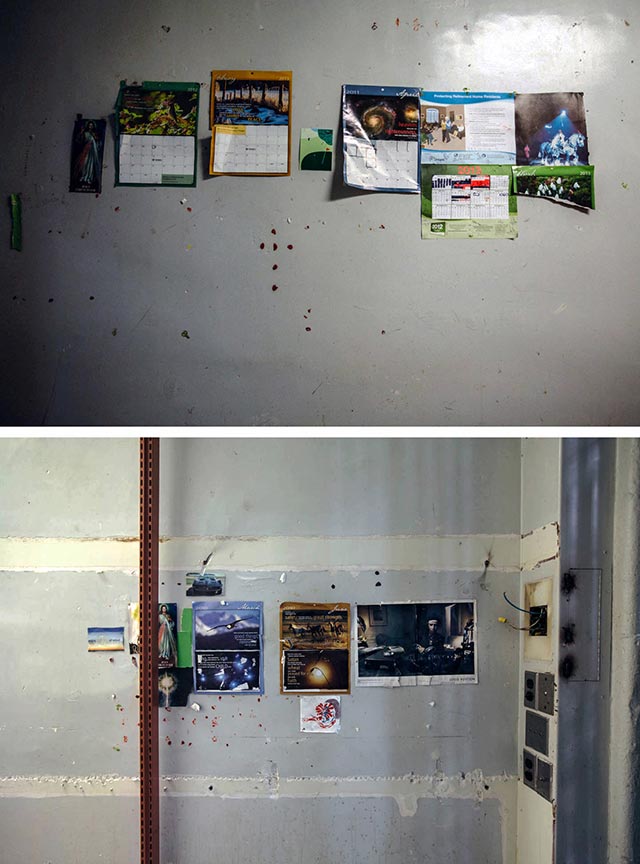 Time: calendars, a poster of horses and sports cars, and a Louis Vuitton magazine ad featuring Bob Dylan remain on the walls of two cells. (Photo: Cindy Blažević)
Time: calendars, a poster of horses and sports cars, and a Louis Vuitton magazine ad featuring Bob Dylan remain on the walls of two cells. (Photo: Cindy Blažević)
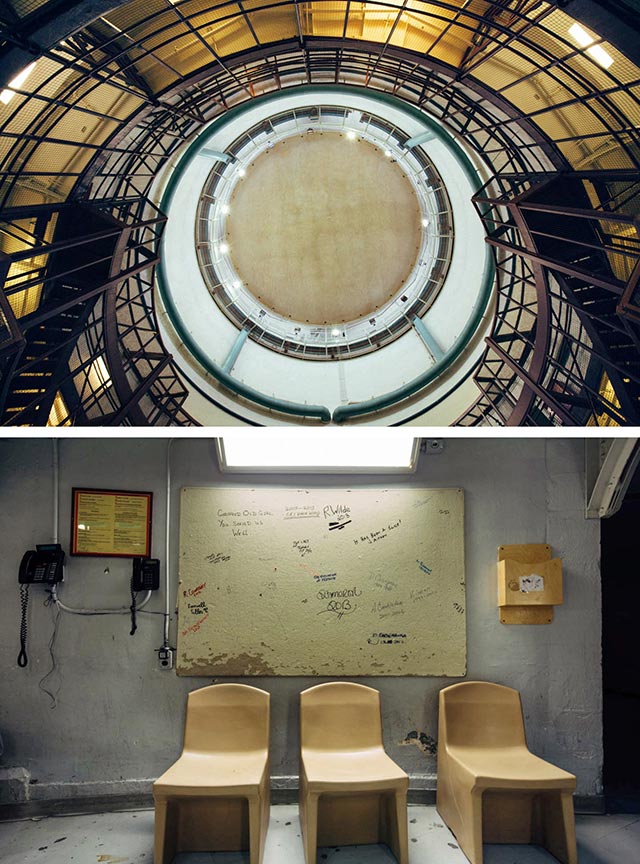 Use of Force: an upward view of the Dome. Beneath, three plastic, prisoner-designed, prisoner-made chairs (incapable of splintering or hiding contraband) sit in front of a notice board covered with the signatures of departing correctional officers. (Photo: Cindy Blažević)
Use of Force: an upward view of the Dome. Beneath, three plastic, prisoner-designed, prisoner-made chairs (incapable of splintering or hiding contraband) sit in front of a notice board covered with the signatures of departing correctional officers. (Photo: Cindy Blažević)
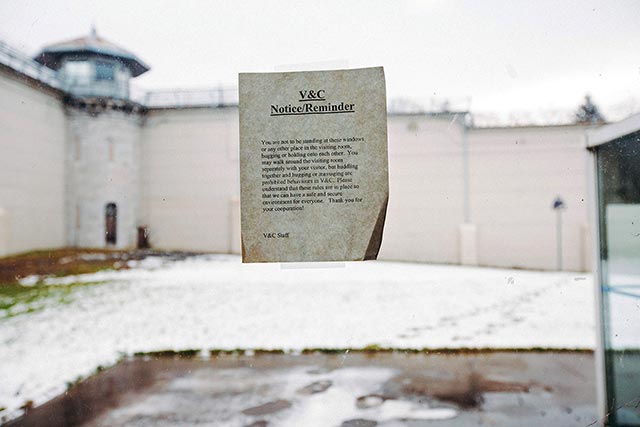 Watchdogging: a notice/reminder/warning to visitors and prisoners is taped to the window inside the Visitation and Correspondence Room. (Photo: Cindy Blažević)
Watchdogging: a notice/reminder/warning to visitors and prisoners is taped to the window inside the Visitation and Correspondence Room. (Photo: Cindy Blažević)
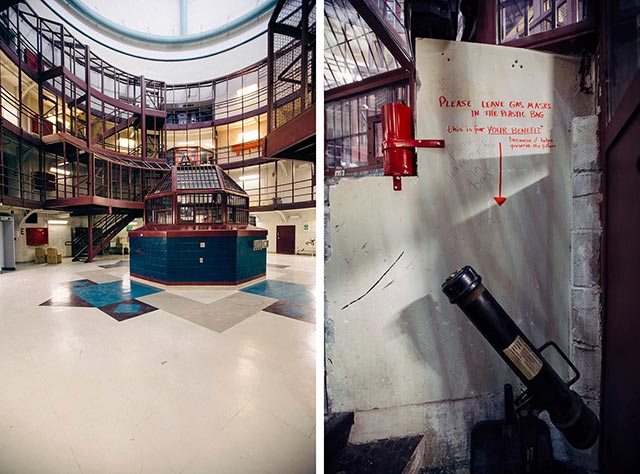 Who Wears the Stab-Proof Vest in the Family: a guard command post inside the Dome (the central point of the prison) is modeled after the principles of Jeremy Bentham’s Panopticon (left). The gas canister inside the command post (right) would typically be used to quell a riot. KP has had four significant riots in its nearly 200-year-old history. (Photo: Cindy Blažević)
Who Wears the Stab-Proof Vest in the Family: a guard command post inside the Dome (the central point of the prison) is modeled after the principles of Jeremy Bentham’s Panopticon (left). The gas canister inside the command post (right) would typically be used to quell a riot. KP has had four significant riots in its nearly 200-year-old history. (Photo: Cindy Blažević)
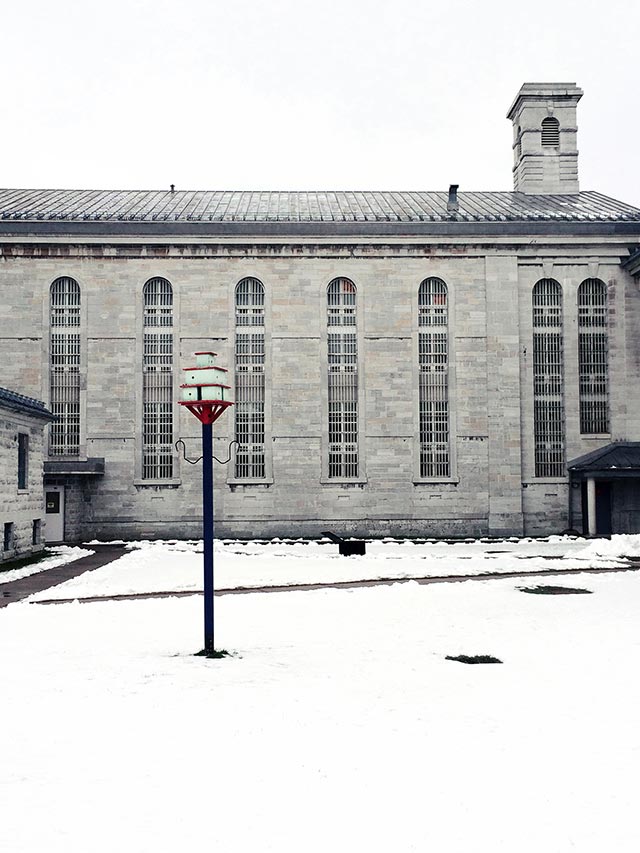 Why the Caged Bird Sings: a mint-colored birdhouse with red trim sits in the courtyard of a cellblock within view of prison cells. (Photo: Cindy Blažević)
Why the Caged Bird Sings: a mint-colored birdhouse with red trim sits in the courtyard of a cellblock within view of prison cells. (Photo: Cindy Blažević)
Angry, shocked, overwhelmed? Take action: Support independent media.
We’ve borne witness to a chaotic first few months in Trump’s presidency.
Over the last months, each executive order has delivered shock and bewilderment — a core part of a strategy to make the right-wing turn feel inevitable and overwhelming. But, as organizer Sandra Avalos implored us to remember in Truthout last November, “Together, we are more powerful than Trump.”
Indeed, the Trump administration is pushing through executive orders, but — as we’ve reported at Truthout — many are in legal limbo and face court challenges from unions and civil rights groups. Efforts to quash anti-racist teaching and DEI programs are stalled by education faculty, staff, and students refusing to comply. And communities across the country are coming together to raise the alarm on ICE raids, inform neighbors of their civil rights, and protect each other in moving shows of solidarity.
It will be a long fight ahead. And as nonprofit movement media, Truthout plans to be there documenting and uplifting resistance.
As we undertake this life-sustaining work, we appeal for your support. We have 10 days left in our fundraiser: Please, if you find value in what we do, join our community of sustainers by making a monthly or one-time gift.